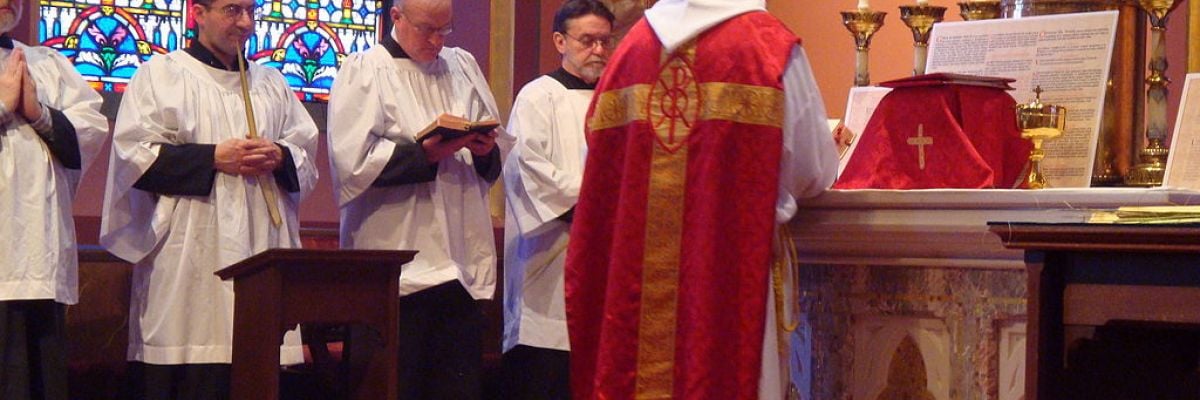
When I was a teenager I read a science-fiction short story about a bet between two supernatural beings: which of them, by meddling in human affairs, could create the largest effect by the smallest stimulus? One of the beings triumphed by convincing a man to change one letter in his last name, starting a causal chain that wound up averting a nuclear war. (Nuclear war being what my generation feared before sentient machines and zombie apocalypses.)
With the exhortation last week by Cardinal Robert Sarah, prefect of the Congregation for Divine Worship, for priests to return to the practice of saying Mass ad orientem—facing “liturgical east” along with the people during the prayers addressing God, instead of versus populum, facing the people—I recalled that story. For I like to think that this seemingly tiny change, too, could produce magnified positive effects. Allow me to suggest three reasons why this may be so.
(Note: some Catholics live for the liturgy wars; I’m not one of them. I have my preferences, of course. But, perhaps because I’ve spent most Masses over the past two decades wrestling with small children, my standards are lower than some others’—as is my knowledge level. When I share these reasons why ad orientem could be a good idea, I do so as an amateur, not an expert or enthusiast.)
1. Ad orientem could lessen clericalism.
Clericalism is the idea that priests belong to a kind of superior caste of Catholics. It’s clericalism to assume that priests occupy a higher plane of sanctity that laymen could never hope to attain; it’s clericalism when priests or bishops lead their flock in an insular or self-privileged manner. Unfortunately, clericalism can make some in the laity believe that their path to fulfilment within the Church lies not in authentic lay discipleship but in imitating what priests do.
The current practice of versus populum, it seems to me, may tend to encourage clericalism by exaggerating the set-apartness of the priest from the people. Rather than communicating what is actually happening when the priest addresses God in prayer—that he does so on behalf of the people—his body orientation can suggest a performance in which he is the star on stage and the people his audience. To put it another way, instead of leading the people before God, he can seem to be brokering God to the people. (I’d be a clericalist, too, if I thought that was the deal.)
But when the priest turns around, he becomes one with the people. Yes, he’s still their leader, still the shepherd, but he’s one of the sheep, too. The differences between clergy and laity—their vocational states of life, their particular authority in the Church, their degrees of religious learning—take a back seat to their shared posture of praise and petition. This, I think, would act as a kind of weekly inoculation against the clericalist disease.
2. Ad orientem could promote true participation in the Mass.
This reason is related to the first. The Second Vatican Council’s call for the laity to practice “active participation” in the Mass (see Sacrosanctum Concilium, chapter 1) doesn’t refer primarily to the people’s gestures, oral responses, singing of hymns, etc., nor to their assuming clerical ministry (for example, as extraordinary ministers of the Eucharist). In fact, a better rendering of the Latin phrase would be “actual participation,” because it means a conscious and intentional presenting of oneself, both interiorly and externally, to the spiritual reality of the liturgy—to become, along with the priest, “thoroughly imbued with [its] spirit and power.”
And so it’s possible to attend Mass and sing, sit, stand, and kneel, shout the responses, jump around and wave one’s hands, even serve as an usher or sacristan, and still not actually participate in the Mass—if you’re not interiorly tuned in to what’s happening. Conversely it’s possible, for an invalid, for example, to do very little during the liturgy but still actually participate.
My Latin-loving friends like to use the expression “assist at Mass” rather than “attend Mass,” for it expresses the collective action taking place: the offering of the sacrifice of Calvary by the people through the priest as their representative. A keen awareness of that action, of that duty, seems to me the very essence of actual participation. Yet the symbolism of versus populum resists such an awareness. Facing the people all the time suggests that the priest is doing something to them, like a doctor, or in front of them, like a magician, rather than with them, united in purpose like a team.
Turn the priest around and the symbolism rights itself. A robust sense of participation returns. We’re no longer an audience but, as it were, part of the show.
3. Ad orientem could promote transcendence.
I’ll say this for the liturgies celebrated by Eastern Catholics and Orthodox: they stress mystery to a greater degree than does Latin-rite Catholicism, which leans more toward order and simplicity. In the East, the liturgy is considered nothing less than a glimpse of heaven, a portal to the eternal. It transcends the earthly church space, the congregation, the listening and sharing and everything else happening among the people present. Its rites, prayers, and postures reflect that transcendence.
Of course, the Mass of the West has the same Eucharist, the same intersection of heaven and earth: at the foot of the Cross re-presented. But I propose that versus populum (which is practiced only in the West, and only these last forty years) conflicts with the sense of transcendence, of looking outward to something beyond what is tangible. The priest and people are closed in upon one another. The eucharistic celebration, meant to express both a sacrifice on an altar and a meal around a table, may appear to trade too much of the former for the latter. The liturgical danger is excessive immanence: a too-earthly, too-human experience. (Some use the terms vertical and horizontal worship to describe transcendence and immanence; the concepts are interchangeable.)
Certainly there are other aspects of the liturgy that play a role in this regard (music, for example). But we mustn’t discount the direction the priest faces when addressing God. If you have ever experienced a Catholic liturgy—Latin, Eastern, Anglican Use—celebrated ad orientem, you may know the subtle but significant effect it can have on your sense of God’s presence. It can be almost startling the first couple of times. When the priest finishes addressing us and turns around that we may all face God together, we go from being guests at a cozy gathering to supplicants at the edge of infinity, calling down the divine fire and, incomprehensibly, communing with it.
I think mystery is a healthy experience, and most of us don’t get enough of it. There’s some reason to doubt that ad orientem is truly coming soon to a church near you. But I pray that the small seed planted by Cardinal Sarah may someday sprout and produce abundant fruits.



